NASA representatives met with the media on Monday and announced that the space shuttle would begin operations again some time between March 11 and April 6. Several safety changes are going to be made before the first shuttle, Atlantis, launches to visit the International Space Station: the bipod ramp (which shed foam on the Columbia launch) will be redesigned, and launch windows will only be in the day so cameras can track the launch. Perhaps the biggest changes, however, will come from NASA’s attempts to change its culture to improve safety. “We will be safety driven, not schedule driven.”
Three Views of Saturn
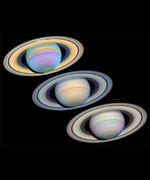
Image credit: Hubble
The planet Saturn reached its maximum tilt towards the Earth last Spring, and astronomers took advantage of the situation to image the ringed planet in three wavelengths of light using the Hubble Space Telescope: ultraviolet, visible, and infrared. Saturn tilts at an angle of 26-degrees and experiences seasons in its hemispheres like the Earth as it travels around the Sun; its orbit takes nearly 30 years. Particles in Saturn’s atmosphere reflect different wavelights of light differently, so the different images can help fill in pieces of missing information.
This is a series of images of Saturn, as seen at many different wavelengths, when the planet’s rings were at a maximum tilt of 26 degrees toward Earth. Saturn experiences seasonal tilts away from and toward the Sun, much the same way Earth does. This happens over the course of its 29.5-year orbit. This means that approximately every 30 years, Earth observers can catch their best glimpse of Saturn’s South Pole and the southern side of the planet’s rings. Between March and April 2003, researchers took full advantage to study the gas giant at maximum tilt. They used NASA’s Hubble Space Telescope to capture detailed images of Saturn’s Southern Hemisphere and the southern face of its rings.
The telescope’s Wide Field Planetary Camera 2 used 30 filters to snap these images on March 7, 2003. The filters span a range of wavelengths. “The set of 30 selected filters may be the best spectral coverage of Saturn observations ever obtained,” says planetary researcher Erich Karkoschka of the University of Arizona. Various wavelengths of light allow researchers to see important characteristics of Saturn’s atmosphere. Particles in Saturn’s atmosphere reflect different wavelengths of light in discrete ways, causing some bands of gas in the atmosphere to stand out vividly in an image, while other areas will be very dark or dull. One image cannot stand by itself because one feature may have several interpretations. In fact, only by combining and comparing these different images, in a set such as this one, can researchers interpret the data and better understand the planet.
By examining the hazes and clouds present in these images, researchers can learn about the dynamics of Saturn’s atmosphere. Scientists gain insight into the structure and gaseous composition of Saturn’s clouds via inspection of images such as these taken by the Hubble telescope. Over several wavelength bands, from infrared to ultraviolet, these images reveal the properties and sizes of aerosols in Saturn’s gaseous makeup. For example, smaller aerosols are visible only in the ultraviolet image, because they do not scatter or absorb visible or infrared light, which have longer wavelengths. By determining the characteristics of the atmosphere’s constituents, researchers can describe the dynamics of cloud formation. At certain visible and infrared wavelengths, light absorption by methane gas blocks all but the uppermost layers of Saturn’s atmosphere, which helps researchers discern clouds at different altitudes. In addition, when compared with images of Saturn from seasons past (1991 and 1995), this view of the planet also offers scientists a better comprehension of Saturn’s seasonal changes.
Original Source: Hubble News Release
Hubble Sees Distant Icy Objects
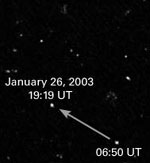
Image credit: Hubble
Using the Hubble Space Telescope, astronomers have discovered three of the faintest and small objects ever seen in the Outer Solar System. Each object is a lump of ice and rock, called a Kuiper Object, that could date back to the creation of the Solar System, 4.5 billion years ago. What’s surprising, however, is how few Kuiper Objects the team discovered. They were expecting to find 60 as small as 15 km in the field they surveyed, but only turned up 3.
Astronomers using NASA’s Hubble Space Telescope have discovered three of the faintest and smallest objects ever detected beyond Neptune. Each object is a lump of ice and rock ? roughly the size of Philadelphia ? orbiting beyond Neptune and Pluto, where the icy bodies may have dwelled since the formation of the solar system 4.5 billion years ago. They reside in a ring-shaped region called the Kuiper Belt, which houses a swarm of icy rocks that are leftover building blocks, or “planetesimals,” from the solar system’s creation.
The results of the search were announced by a group led by astronomer Gary Bernstein of the University of Pennsylvania at today’s meeting of the Division of Planetary Sciences in Monterey, Calif.
The study’s big surprise is that so few Kuiper Belt members were discovered. With Hubble’s exquisite resolution, Bernstein and his co- workers expected to find at least 60 Kuiper Belt members as small as 10 miles (15 km) in diameter ? but only three were discovered.
“Discovering many fewer Kuiper Belt objects than was predicted makes it difficult to understand how so many comets appear near Earth, since many comets were thought to originate in the Kuiper Belt,” Bernstein says. “This is a sign that perhaps the smaller planetesimals have been shattered into dust by colliding with each other over the past few billion years.”
Bernstein and his colleagues used Hubble to look for planetesimals that are much smaller and fainter than can be seen from ground-based telescopes. Hubble’s Advanced Camera for Surveys was pointed at a region in the constellation Virgo over a 15-day period in January and February 2003. A bank of 10 computers on the ground worked for six months searching for faint-moving spots in the Hubble images.
The search netted three small objects, named 2003 BF91, 2003 BG91, and 2003 BH91, which range in size from 15-28 miles (25-45 km) across. They are the smallest objects ever found beyond Neptune. At their current locations, these icy bodies are a billion times fainter (29th magnitude) than the dimmest objects visible to the naked eye. But an icy body of this size that escapes the Kuiper Belt to wander near the Sun can become visible from Earth as a comet as the wandering body starts to evaporate and form a surrounding cloud.
Astronomers are probing the Kuiper Belt because the region offers a window on the early history of our solar system. The planets formed over 4 billion years ago from a cloud of gas and dust that surrounded the infant Sun. Microscopic bits of ice and dust stuck together to form lumps that grew from pebbles to boulders to city- or continent-sized planetesimals. The known planets and moons are the result of collisions between planetesimals. In most of the solar system, all of the planetesimals have either been absorbed into planets or ejected into interstellar space, destroying the traces of the early days of the solar system.
Around 1950, Gerard Kuiper and Kenneth Edgeworth proposed that in the region beyond Neptune there are no planets capable of ejecting the leftover planetesimals. There should be a zone, the two astronomers said? now called the Kuiper Belt ? filled with small, icy bodies. Despite many years of searching, the first such object was not found until 1992. Since then, astronomers have discovered nearly 1,000 from ground-based telescopes. Most astronomers now believe that Pluto, discovered in 1930, is in fact a member of the Kuiper Belt.
Astronomers now use the Kuiper Belt to learn about the history of the solar system, much as paleontologists use fossils to study early life. Each event that affected the outer solar system ? such as possible gravitational disturbances from passing stars or long-vanished planets ? is frozen into the properties of the Kuiper Belt members that astronomers see today.
If the Hubble telescope could search the entire sky, it would find perhaps a half million planetesimals. If collected into a single planet, however, the resulting object would be only a few times larger than Pluto. The new Hubble observations, combined with the latest ground-based Kuiper Belt surveys, reinforce the idea that Pluto itself and its moon Charon are just large Kuiper Belt members. Why the Kuiper Belt planetesimals did not form a larger planet, and why there are fewer small planetesimals than expected, are questions that will be answered with further Kuiper Belt studies. These studies will help astronomers understand how planets may have formed around other stars as well.
The new Hubble results were reported by Bernstein and David Trilling (University of Pennsylvania); Renu Malhotra (University of Arizona); Lynne Allen (University of British Columbia); Michael Brown (California Institute of Technology); and Matthew Holman (Harvard-Smithsonian Center for Astrophysics). The results have been submitted to the Astronomical Journal for publication, and a preliminary report is available on the Web at http://arxiv.org/abs/astro-ph/0308467.
Original Source: Hubble News Release
Senate Approves $15.3 Billion Budget for NASA
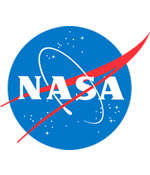
Image credit: NASA
On the heels of the release of the Columbia Accident Investigation report, the United Stats Senate Appropriations Committee approved NASA’s $15.3 billion budget for 2004. There were only a few differences from this budget and the $15.5 billion requested by President Bush earlier this year. $200 million was cut in from the International Space Station because of the smaller crew and use of Soyuz spacecraft. $20 million was cut from the Jupiter Icy Moons Orbiter (JIMO) mission; although, the explained that this amount had been added last year and not used. There were no other major cuts or changes to NASA’s budget.
? The bill has NASA funded at $15.3 billion. This is the same as the amount enacted in FY 2003.
? The Human Space Flight makes no changes to the funding in the Shuttle account, but are encourages NASA to keep Congress notified of any changes to this program resulting from the Columbia Accident Investigation Board (CAIB). The report requires NASA to provide a comprehensive plan within 4 months regarding response to the CIAB, as well as a 10-year funding profile for all of Shuttle fleet as safe and the proposed changes. The report expresses concern over what the impacts of the CAIB recommendations will be, and if there is a restructuring at NASA, what the long-term implications of a reorganization may be. We are also making limitations that will not allow NASA to move funds away from the Shuttle program.
? The bill includes a reduction of $200 million for the International Space Station (ISS). With the current situation aboard the station of a reduced crew and Russians supplying vehicles for crew and cargo transfer, there are other pressing needs within NASA and the bill for funds. At this time, NASA is unsure as to when the ISS will be operating with a crew of three, it may only be for a few more months or it could be longer than a year. The ISS has reserves of over $250 million and should be able to cover this modest reduction.
? The Science, Aeronautics, and Exploration fund is funded at the request with the exception of a $20 million reduction for the Jupiter Icy Moons Orbiter. This reduction corresponds to a similar amount funded into the program last year, but that was not requested. The result is that the funding for the program is equal to the FY 2004 request, but is spread over two fiscal years, but actually 8 calendar months. There is also $50 million in additional funds that go towards aeronautics research. The bill also has some other minor adjustments to other programs, but there are no major cuts or terminations to any programs within this portion of the bill.
? NASA has come to the Committee in the recent past about various human capitol issues, including retention bonuses and increased buyout authority. The bill asks for NASA to report on what they feel the budgetary impacts of such practices will be, both initially and over the long term. The bill includes a requirement that the National Academy of Public Administration do a top to bottom management analysis of NASA, particularly in response to the CAIB report which cited NASA management and culture as being a factor in the Columbia accident.
Source: US Press Release
Asteroids are Probably a Threat. Maybe?
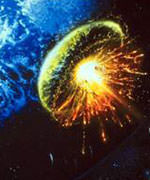
Image credit: NASA
As potentially killer asteroids are announced on an almost yearly basis, the public is started to get a little jaded about the risks humanity faces. How can governments and space agencies confront a threat that can only be a “maybe” until it’s too late to do anything about it? Here’s my opinion.
Well, you can all breath a sigh of relief, 2003 qq47 isn’t going to smash into Earth on March 21, 2014 and cause widespread death and destruction. But then, if you’ve been a regular follower of space news, you’re probably not really surprised. Astronomers release a warning almost every year that a space rock has some outside chance of striking the Earth, and then revise their estimates shortly afterwards thanks to more observations.
The first big rock to freak out the public was Asteroid 1997 XF11; it was supposed to strike the Earth in October 26, 2028. Even though the original threat was still remote, the mass media picked up on this. There were full-page articles in major newspapers, the cover of magazines, and on the evening news. Astronomers quickly followed up the story with a retraction. Not only would XF11 miss the Earth, it would miss by almost a million kilometres, or 2.5 times further than the Moon.
New reports of killer asteroids have come out in the following years, with wiser astronomers being a little more conservative in their predictions. With QQ47, the first stories pegged the chances of a strike at 1 in 909,000; not much higher than the background risk that the Earth faces every year from getting hit by an asteroid. The risk has since been downgraded.
As automated asteroid searches continue to search the sky, potential planet smashers are going to be spotted quite regularly. Astronomers will provide conservative calculations, and a jaded public will treat each announcement with even more skepticism. When the 37th potential killer asteroid is announced, it’ll make little more than a blip in the general media – that’s understandable.
The unspoken goal for finding asteroids is to prevent one of them from ever striking the Earth and causing damage. In theory, the sooner you find a killer asteroid, the longer you have to adjust its orbit and save the Earth from destruction. If a collision is only a couple of months away, there’s little to do but prepare for the worst. But if it’s years or even decades away, spacecraft could be launched to nudge the asteroid into a less hazardous trajectory.
Astronomers are going to keep a watchful eye on the sky, to alert governments and the public to any future risks. But the problem is that astronomers deal in probabilities. They won’t say a certain asteroid WILL hit the Earth (like in Armageddon); instead they’ll say that it can hit the Earth.
That it may hit the Earth.
Will governments and space agencies be decisive enough to spend billions of dollars changing an asteroid’s orbit when they aren’t sure it’s even necessary. The longer you wait, the better the calculations become, but the less time you have to defend against it. With more data, astronomers will likely be tracking dozens of potential Earth-crossers with varying risks and dates that they’ll strike our planet. How do we decide which asteroids need to be moved and which can wait?
I don’t think we’re ever going to have a clear-cut challenge that will unite humanity against a common threat. If we did, it would probably only be months away and there’d be little we could do about it. Just take a look at global warming. Even though the evidence seems to be saying that humans have warmed the planet a degree in the last century, the worldwide response is denial and procrastination.
So what’s the solution? I honestly don’t know if governments and space agencies can really get organized and decisive around such a nebulous threat (the threat is real, though, with the potential for unlimited damage). Investing in basic research is probably the best solution; better funding for observatories to discover and map asteroid trajectories; new propulsion systems that could help push an asteroid out of the way. Maybe if engineers deliver better solutions, it will help procrastinating governments take action at the last minute.
Keck Gets a Clear View of Asteroid (511) Davida
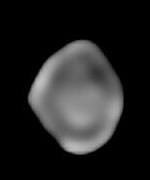
Image credit: Keck
A team of astronomers have used the 10-metre Keck II telescope to create a series of images that show asteroid (511) Davida from every angle. The images of the 320 km asteroid were taken in late December, 2002 using the Keck’s adaptive optics system – a special technology that allows the telescope to compensate for distortion caused by the Earth’s atmosphere. The observations are so precise that features as small as 46 km can be seen on the surface of the asteroid.
A team of scientists from the W.M. Keck Observatory and several other research institutions have made the first full-rotational, ground-based observations of asteroid (511) Davida, a large, main-belt asteroid that measures 320 km (200 miles) in diameter. These observations are among the first high-resolution, ground-based pictures of large asteroids, made possible only through the use of adaptive optics on large telescopes. This research will help improve understanding of how asteroids were formed and provide information about their compositions and structures. Because the asteroids were formed and shaped by collisions, a process that also affected the Earth, Moon, and planets, these studies will also help astronomers understand the history and evolution of the solar system.
” Asteroid Davida was discovered 100 years ago, but this is the first time anyone has been able to see this level of detail on this object,” said Dr. Al Conrad, scientist at the W.M. Keck Observatory. “With adaptive optics, we’re finally able to transform asteroids like Davida from a single, faint point-source into an object of true geological study.”
Ground-based observations of large, main-belt asteroids are made possible only through a powerful astronomical technique called adaptive optics, which removes the blurring caused by Earth’s atmosphere. Without adaptive optics, critical surface information and details about the asteroid’s shape are lost. The techniques used at the W.M. Keck Observatory allow astronomers to measure the distortion of light caused by the atmosphere and rapidly make corrections, restoring the light to near-perfect quality. Such corrections are most easily made to infrared light. In many cases, infrared observations made with Keck adaptive optics are better than those obtained with space-based telescopes.
The observations of asteroid (511) Davida were made with the 10-meter (400-inch) Keck II telescope on December 26, 2002. Images were taken over a full rotation period of about 5.1 hours, just a few days before its closest approach to Earth. At that time, Davida’s angular diameter was less than one-ten-thousandth of a degree, about the size of a quarter as seen from a distance of 18 kilometers (11 miles). The high angular resolution allowed astronomers to see surface details as small as 46 kilometers (30 miles), about the size of the San Francisco Bay area. The next time Davida comes this close to Earth will be in the year 2030.
At the time of the observations, Davida?s north pole faced Earth. While scientists could see the asteroid spinning, only the northern hemisphere was visible. Yet the profile of the asteroid is far from circular: At least two flat facets can be seen on its surface. Although scientists knew previously from light variations that Davida must have an oblong shape, details of that shape were not available until now. Initial evaluation of the images reveal some dark features, and scientists are still working to understand to what extent these are surface markings, topographical features, or artifacts of the image processing.
” Adaptive optics on large telescopes is allowing us to make detailed studies from the ground that were previously impossible or prohibitively expensive,” said Dr. William Merline, principal scientist with the Southwest Research Institute, and a participant in this research. “We can now make observations that once required either the scarce resources of space telescopes or spacecraft missions to asteroids. While these space telescopes and space missions are still needed for complete study of the asteroids, ground-based observations such as these will help tremendously in planning the mission observations and focusing the resources where they will be most effective.”
Asteroids are the collection of rocky objects orbiting between Mars and Jupiter. They were likely prevented from forming into a planet, partly due to Jupiter’s massive gravitational influence.
? Although the asteroids began their lives colliding gently, in a way that would lead them eventually to form a planet, Jupiter’s gravity eventually stirred up their orbits, and they began to collide at higher speeds,? added participant Dr. Christophe Dumas, planetary astronomer with the Jet Propulsion Laboratory. ?These collisions tended to cause them to break up rather than gently stick together. The resulting fragments, numbering in the hundreds of thousands, are the asteroids we see today. They collide with each other and have impacted the Earth, Moon, and planets over time. One need only look at the scarred surface of our Moon to see the cumulative result. Study of the asteroid’s shape, size, and surface features helps us understand how these collisions operate and thus how our planet was, and still is, being affected by these impacts.?
Observations of the shapes of asteroids, such as those released today, can tell us about the types and severity of impacts that occurred, and possibly also give clues into the overall structure of an asteroid — for example, whether it may be solid rock, or a jumble of smaller rocks. Surface features can reveal a history of large impacts or variations in the composition that should, in turn, further help us understand the asteroid’s history.
Asteroid (511) Davida was discovered by R. S. Dugan in 1903 in Heidelberg, Germany. The (511) in Davida’s name means it was the 511th asteroid to be discovered and included in the list of asteroids maintained by the International Astronomical Union.
Team members responsible for the observations are Al Conrad, David Le Mignant, Randy Campbell, Fred Chaffee, Robert Goodrich, Shui Kwok of the W.M. Keck Observatory; Christophe Dumas, Jet Propulsion Laboratory; William Merline, Southwest Research Institute; Heidi Hammel, Space Science Institute; and Thierry Fusco, Onera, France.
The W.M. Keck Observatory is operated by the California Association for Research in Astronomy, a scientific partnership of the California Institute of Technology, the University of California, and the National Aeronautics and Space Administration.
Source: Keck Press Release
Hubble Took Its Time Watching This Galaxy
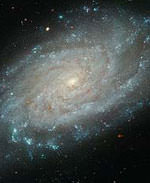
Image credit: Hubble
The latest image released from the Hubble Space Telescope is of the spiral galaxy NGC 3370, located in the constellation Leo. The galaxy was imaged because astronomers wanted to observe Cepheid variable stars – special stars which brighten and dim at a known rate and are used to calculate distances to objects. The team had to make a long exposure of the galaxy (about a full day), so Hubble had a chance to gather a lot of light; that’s why there are many fainter galaxies visible in the background of the picture.
Amid a backdrop of far-off galaxies, the majestic dusty spiral, NGC 3370, looms in the foreground in this NASA Hubble Space Telescope image. Recent observations taken with the Advanced Camera for Surveys show intricate spiral arm structure spotted with hot areas of new star formation. But this galaxy is more than just a pretty face. Nearly 10 years earlier NGC 3370, in the constellation Leo, hosted a bright exploding star.
In November 1994, the light of a supernova in nearby NGC 3370 reached Earth. This stellar outburst briefly outshone all of the tens of billions of other stars in its galaxy. Although supernovae are common, with one exploding every few seconds somewhere in the universe, this one was special. Designated SN 1994ae, this supernova was one of the nearest and best observed supernovae since the advent of modern, digital detectors. It resides 98 million light-years (30 megaparsecs) from Earth. The supernova was also a member of a special subclass of supernovae, the type Ia, the best tool astronomers have to chart the growth rate of the expanding universe.
Recently, astronomers have compared nearby type Ia supernovae to more distant ones, determining that the universe is now accelerating in its expansion and is filled with mysterious “dark energy.” Such measurements are akin to measuring the size of your room by stepping it off with your feet. However, a careful measurement of the length of your foot (to convert your measurements into inches or centimeters) is still needed to know the true size of your room. Similarly, astronomers must calibrate the true brightness of type Ia supernovae to measure the true size and expansion rate of the universe.
The very nearest type Ia supernovae, such as SN 1994ae, can be used to calibrate distance measurements in the universe, because other, fainter stars of known brightness can be observed in the same galaxy. These stellar “standard candles” are the Cepheid variable stars, which vary regularly in brightness with periods that are directly related to their intrinsic brightness, and thus allow the distance to the galaxy?and the supernova?to be determined directly. However, only the Hubble Space Telescope, equipped with its new Advanced Camera for Surveys, has the capability to resolve these individual Cepheids.
Adam Riess, an astronomer at Space Telescope Science Institute in Baltimore, Md., observed NGC 3370 a dozen times over the course of a month and has seen many Cepheid variables. Already he and his colleagues can see that these Cepheids are the most distant yet observed with Hubble. Because of their need to observe this galaxy with great frequency to record the variation of the Cepheids, the total exposure time for this galaxy is extremely long (about one full day), and the combined image provides one of the deepest views taken by Hubble. As a result, thousands of distant galaxies in the background are easily discernable.
Dr. Riess imaged NGC 3370 with Hubble in early 2003. His science only required looking at NGC 3370 in two filters that covered the visual and infrared portions of the spectrum. By teaming up with the Hubble Heritage Project, a third blue filter was added to the data to produce the composite three-color image that is shown.
Credit: NASA, The Hubble Heritage Team and A. Riess (STScI)
Source: Hubble Press Release
Articles on Universe Today
Hi folks, I’ve made a pretty significant change to the way Universe Today is structured with this issue. It looks similar at first glance, but instead of only linking to outside press releases, I’m reformating them and incorporating them into Universe Today. I decided to do this after browsing through some of my older archives and I realized how poorly outside websites maintain their older content. A lot of my older links are just dead, which is too bad, because the material is sometimes only a few months old.
I’m still going to link to outside articles as well, such as the first story today, which goes out to Yahoo news. I’ll try and figure out a way to distinguish between the two if that’s a concern for you. I’m still maintaining a link to the original source at the end of the story, so you can still see the original press release (as long as it lasts).
Let me know what you think. In other news, it looks like the AOL subscribers got the newsletter yesterday after silence for several weeks. I’m not sure how long AOL will let you get this newsletter, so if you stop getting it again, please complain to AOL and demand they let mail from [email protected] through.
Thanks!
Fraser Cain
Publisher
Universe Today
Senate Inquiry Comes Down Hard on NASA
With the Columbia accident report complete, US senators began a series of inquiries into how NASA has responded to the challenges that its culture and lack of safety concerns ultimately contributed to the shuttle’s destruction. NASA Administrator Sean O’Keefe received stinging criticism from the Senate committee on Commerce, Science and Transportation that NASA hadn’t fired enough people after the accident – O’Keefe felt it was pointless to name people responsible for the accident if they hadn’t acted maliciously. The committee then demanded that NASA prepare a report to analyze the cost and benefits of space flight. (Source: AP)
Grunsfeld Becomes NASA’s Chief Scientist
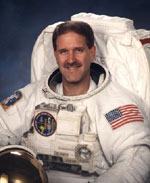
Image credit: NASA
NASA Administrator Sean O’Keefe announced today that astronaut Dr. John Grunsfeld would replace Dr. Shannon Lucid as the agency’s Chief Scientist. Grunsfeld is a veteran of four space shuttle flights, including two servicing missions to the Hubble Space Telescope and has studied astronomy and physics throughout his career. Lucid will return to the Johnson Space Center in Houston to assist with the shuttle’s return to flight activities.
Administrator Sean O’Keefe today announced the selection of veteran astronaut, astronomer, and astrophysicist Dr. John M. Grunsfeld as the agency’s new Chief Scientist at NASA Headquarters in Washington. He succeeds Dr. Shannon Lucid, effective immediately.
Grunsfeld, who played an integral role in two Space Shuttle servicing missions to the Hubble Space Telescope (HST), has studied astronomy and physics throughout his career. As NASA’s Chief Scientist, he’ll work to ensure the scientific merit of the agency’s programs.
“John has a deep interest in astronautical science and has the hands-on experience to back up what he has taught in the classroom,” said Administrator O’Keefe. “With his background in physics and astronomy, John is a natural selection to direct NASA’s important space-based science objectives.”
After serving nearly two years in Washington, Lucid will return to the NASA Johnson Space Center in Houston to assist the agency’s Return to Flight efforts. “I asked Shannon to come to Washington to help get our science priorities in order,” added Administrator O’Keefe. “Thanks to her leadership, and work with Mary Kicza, our Associate Administrator for Biological and Physical Research, our research goals have focus and a clear direction. Shannon’s insight and candor will be missed in Washington, but I’m sure her colleagues in Houston are looking forward to her return.”
She was selected as Chief Scientist in February 2002. During her tenure, one of Lucid’s most important tasks was to work with the offices of Biological and Physical Research, Earth Science, Space Science, and Space Flight to develop a comprehensive plan for prioritization of research on board the International Space Station.
Lucid also updated NASA’s science policy, which had not been done since 1996. The policy stipulates science grants will be peer reviewed, and NASA scientists must compete for research funding.
She joined NASA in 1978 and became an astronaut in August 1979. She has flown as a mission specialist on STS-51G in 1985, STS-34 in 1989, STS-43 in 1991 and STS-58 in 1993. In 1996, she was flown to Mir during STS-76, where she served as an engineer and conducted numerous life science and physical science experiments during her stay in orbit.
When Lucid returned to Earth after STS-79, she had traveled more than 75 million miles and spent more than 188 days in orbit, an American record at the time. For her extraordinary efforts, Lucid was awarded the Congressional Space Medal of Honor.
Grunsfeld is a veteran of four Space Shuttle flights. In1999 and 2002 he took part in a total of five successful spacewalks to upgrade Hubble. As a Mission Specialist on STS-103, Grunsfeld helped install new gyroscopes and scientific instruments and upgraded Hubble’s systems. During STS-109, he served as Payload Commander, in charge of the spacewalking activities and the HST payload. He and three other crewmates installed a new digital camera, cooling system for the infrared camera, new solar arrays, and power system.
“Servicing the Hubble Space Telescope is by far and away the most meaningful thing I’ve ever done. It’s helping us answer fundamental questions about our world and our place in the universe,” said Grunsfeld. “I was born the same year NASA was established, so we grew up together. I quickly discovered space exploration and science mesh well together and I couldn’t be more excited about this opportunity.”
A native of Chicago, Grunsfeld received a bachelor’s degree in physics from the Massachusetts Institute of Technology in 1980. He earned a masters degree and a doctorate in physics from the University of Chicago in 1984 and 1988, respectively.
Grunsfeld was selected as a NASA astronaut in 1992. His first flight assignment came in 1995 on board the Space Shuttle Endeavour on STS-67. In 1997, Grunsfeld served as flight engineer for the Space Shuttle Atlantis during STS-81 and a 10-day mission to Russia’s Mir space station. He has logged over 45 days in space, including 37 hours and 32 minutes working outside the Space Shuttle.
Grunsfeld has been honored with the W.D. Grainger Fellow in Experimental Physics and was awarded the NASA Distinguished Service Medal earlier this year. He was awarded NASA Space Flight Medals in 1995, 1997, 1999, and 2002, and earned the agency’s Exceptional Service Medal in 1997, 1998, and 2000.
Source: NASA Press Release
